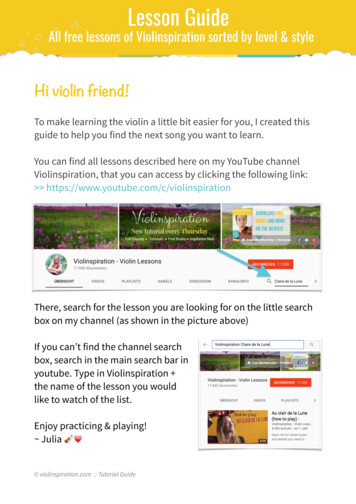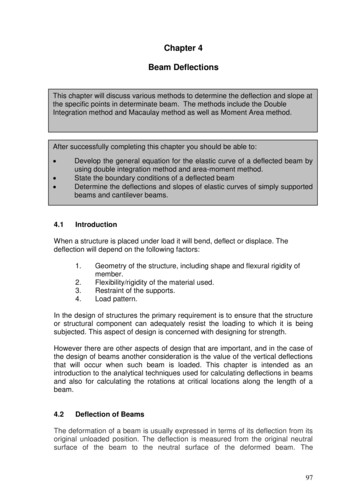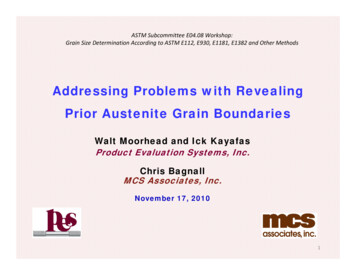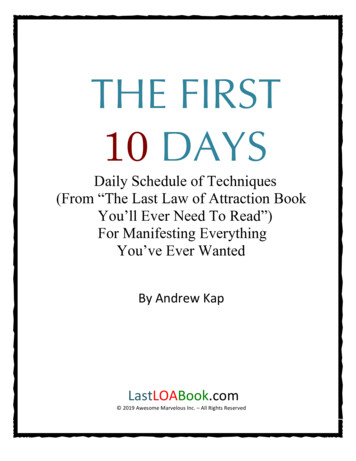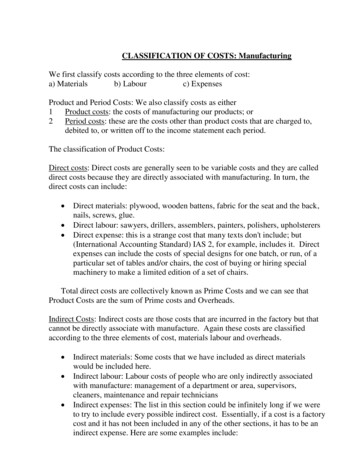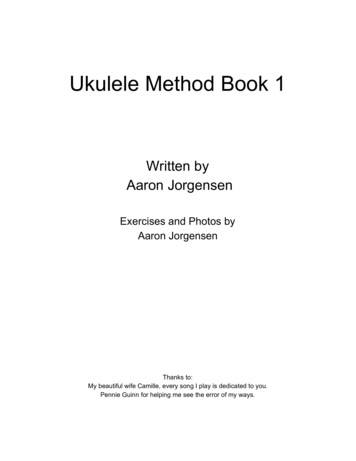
Transcription
Who: The A Method for HiringNotes by Frumi Rachel Barr, MBA, PhD.Authors: Geoff Smart and Randy StreetPublisher: Ballantine BooksCopyright year: 2008eISBN: 978-0-345-51044-0Authors’ Bios:Geoff Smart is chairman and founder of ghSMART, an advisory firm that exists to help leaders amplify theirpositive impact on the world. He is author of the New York Times bestseller Leadocracy and co-author ofPower Score.Randy Street is managing partner of ghSMART and co-author of Power Score. He is a leadership advisor toboards and CEOs, and an internationally acclaimed public speakerAuthors’ big thought: Based on more than 1,300 hours of interviews with more than 20 billionaires and 300CEOs, Who presents Smart and Street’s A Method for Hiring. Refined through the largest research study of itskind ever undertaken, the A Method stresses fundamental elements that anyone can implement–and it has a90 percent success rate.Introduction: Who, Not What“The most important decisions that businesspeople make are not what decisions, but who decisions.” – JimCollins, author of Good to Great What refers to the strategies you choose, the products and services you sell, and the processes youuse. Who refers to the people you put in place to make the what decisions. Who is running your salesforce? Who is assembling your product? Who is occupying the corner office? Who is where the magicbegins, or where the problems start. The authors talked with and listened to many of the world’s most talented leaders as they taught theirsecrets to hiring success. More than twenty business billionaires, most of them self-made, contributedtheir insights and experiences to this book, an unprecedented assemblage. Out of a mountain of research, they have identified four parts of the hiring process where failuretypically occurs. Who mistakes happen when managers:1. Are unclear about what is needed in a jobDrFrumi@Scaling4Growth.comwww.100mustreads.com1
2. Have a weak flow of candidates3. Do not trust their ability to pick out the right candidate from a group of similar-looking candidates4. Lose candidates they really want to join their teamThese Who mistakes are pricey. The average hiring mistake costs fifteen times an employee’s basesalary in hard costs and productivity loss.What most managers do not know is that Who problems are preventable.The purpose of this book is to give you a solution to your number-one problem – to help you makebetter Who decisions.Chapter 1: Your #1 problem The method the authors share will do the due diligence for you. It lets you focus on the individualcandidates without losing sight of the goals and values of your organization. Before their method can work to its optimal level, though, chances are you might have to break somebad hiring habits of your own.The top ten Voodoo Hiring techniques are:1. The Art Critic: Forgers can pass off fake paintings as real ones to the time-pressed buyer, and peoplewho want a job badly enough can fake an interview if it lasts only a few minutes. Gut instinct is terriblyinaccurate when it comes to hiring someone.2. The Sponge: A common approach among busy managers is to let everybody interview a candidate toget as much info as possible.3. The prosecutor: Managers aggressively question candidates, attempting to trip them up with trickquestions and logics problems. You may find someone knowledgeable that way but knowledge and theability to do the job are not the same thing.4. The Suitor: Suitors are more concerned with impressing candidates than assessing their capabilities.They spend all of their time in an interview talking and virtually no time listening.5. The Trickster: the interviewers who use gimmicks to test for certain behaviors.6. The Animal Lover: Asking what type of animal would you be – there is no scientific basis orrelevance.7. The Chatterbox: Although enjoyable, this method does nothing to help you make a good decision.8. The Psychological and Personality Tester: These types of tests are not recommended as they are notpredictive of success on the job.9. The Aptitude Tester: They can help determine whether the candidate has the right aptitude for thejob but they should never be the sole determinant in a hiring decision.10. The Fortune Teller: Some interviewers like to ask their candidates to look into the future regardingthe job at hand by asking hypothetical questions: At the bottom line, all these voodoo hiring methods share an assumption that it’s easy to assess aperson.What is an A Player? Think of an A Player as the right superstar, a talented person who can do the job you need done, whilefitting in with the culture of your company. An A Player is defined this way: a candidate who has atleast a 90 percent chance of achieving a set of outcomes that only the top 10 percent of possiblecandidates could achieve. Hiring A Players takes hard work. As we’ll see, it’s not always for the faint of heart. You have to dighard, ask tough questions, and be prepared sometimes for disturbing .com2
In business, you are who you hire. Hire C Players, and you will always lose to the competition. Hire BPlayers, and you might do okay, but you will never break out. Hire A Players, and life gets veryinteresting no matter what you are pursuing.How do you get an A team? The A Method defines a simple process for identifying and hiring A Players with a high degree ofsuccess. It helps you get the Who right. There are four steps:1. Scorecard. The scorecard is a document that describes exactly what you want a person toaccomplish in a role. It is not a job description, but rather a set of outcomes and competenciesthat define a job done well. By defining A performance for a role, the scorecard gives you aclear picture of what the person you seek needs to be able to accomplish.2. Source. Finding great people is getting harder, but it is not impossible. Systematic sourcingbefore you have slots to fill ensures you have high-quality candidates waiting when you needthem.3. Select. Selecting talent in the A Method involves a series of structured interviews that allow youto gather the relevant facts about a person so you can rate your scorecard and make aninformed hiring decision. These structured interviews break the voodoo hiring spell.4. Sell. Once you identify people you want on your team through selection, you need to persuadethem to join. Selling the right way ensures you avoid the biggest pitfalls that cause the verypeople you want the most to take their talents elsewhere. It also protects you from the biggestheartbreak of all— losing the perfect candidate at the eleventh hour.Chapter 2: Scorecard: A Blueprint for Success Scorecards describe the mission for the position, outcomes that must be accomplished, andcompetencies that fit with both the culture of the company and the role.The first failure point of hiring is not being crystal clear about what you really want the person you hireto accomplish.Mission: The Essence of the Job The mission is an executive summary of the job’s core purpose. It boils the job down to its essence soeverybody understands why you need to hire someone into the slot. For a mission to be meaningful, it has to be written in plain language. Don’t Hire the Generalist. Hire the Specialist. Mission statements help you avoid one of the mostcommon hiring traps: hiring the all-around athlete. A final caution about mission. You can’t just pull a mission off the shelf and dust it off whenever theposition needs refilling.Outcomes: Defining What Must Get Done Outcomes, the second part of a scorecard, describe what a person needs to accomplish in a role. Mostof the jobs for which we hire have three to eight outcomes, ranked by order of importance. An A Player will be able to accomplish the desired outcome, and a B or C Player won’t. Outcomes arethat clear, and because they are, they cull the pool of possible candidates right from the om3
While typical job descriptions break down because they focus on activities, or a list of things a personwill be doing (calling on customers, selling), scorecards succeed because they focus on outcomes, orwhat a person must get done (grow revenue from 25 million to 50 million by the end of year three).Not all jobs allow you to quantify the outcome so easily. In these cases, seek to make the outcomes asobjective and observable as possible.Competencies: Ensuring Behavioral Fit Competencies flow directly from the first two elements of the scorecard. The mission defines theessence of the job to a high degree of specificity. Outcomes describe what must be accomplished. Competencies define how you expect a new hire to operate in the fulfillment of the job and theachievement of the outcomes.Critical Competencies for A Players Efficiency. Able to produce significant output with minimal wasted effort. Honesty/ integrity. Does not cut corners ethically. Earns trust and maintains confidences. Does what isright, not just what is politically expedient. Speaks plainly and truthfully. Organization and planning. Plans, organizes, schedules, and budgets in an efficient, productivemanner. Focuses on key priorities. Aggressiveness. Moves quickly and takes a forceful stand without being overly abrasive. Follow-through on commitments. Lives up to verbal and written agreements, regardless of personalcost. Intelligence. Learns quickly. Demonstrates ability to quickly and proficiently understand and absorbnew information. Analytical skills. Able to structure and process qualitative or quantitative data and draw insightfulconclusions from it. Exhibits a probing mind and achieves penetrating insights. Attention to detail. Does not let important details slip through the cracks or derail a project. Persistence. Demonstrates tenacity and willingness to go the distance to get something done. Proactivity. Acts without being told what to do. Brings new ideas to the company. Ability to hire A Players (for managers). Sources, selects, and sells A Players to join a company. Ability to develop people (for managers). Coaches people in their current roles to improveperformance, and prepare them for future roles. Flexibility/ adaptability. Adjusts quickly to changing priorities and conditions. Copes effectively withcomplexity and change. Calm under pressure. Maintains stable performance when under heavy pressure or stress. Strategic thinking/ visioning. Able to see and communicate the big picture in an inspiring way.Determines opportunities and threats through comprehensive analysis of current and future trends. Creativity/ innovation. Generates new and innovative approaches to problems. Enthusiasm. Exhibits passion and excitement over work. Has a can-do attitude. Work ethic. Possesses a strong willingness to work hard and sometimes long hours to get the job done.Has a track record of working hard. High standards. Expects personal performance and team performance to be nothing short of the best. Listening skills. Lets others speak and seeks to understand their viewpoints. Openness to criticism and ideas. Often solicits feedback and reacts calmly to criticism or negativefeedback. Communication. Speaks and writes clearly and articulately without being overly verbose or talkative.Maintains this standard in all forms of written communication, including com4
Teamwork. Reaches out to peers and cooperates with supervisors to establish an overall collaborativeworking relationship.Persuasion. Able to convince others to pursue a course of action.Cultural Competencies: Ensuring Organizational Fit Competencies work at two levels. They define the skills and behaviors required for a job, and theyreflect the broader demands of your organizational culture. Job competencies are generally easier tolist, but cultural fit is just as important. Evaluating culture sometimes means removing people who are not a fit. Culture fits- or misfits – inevitably affect the bottom line, but they are about much more than money. Scorecards are the guardians of your culture. They encapsulate on paper the unwritten dynamics thatmake your company what it is, and they ensure you think about those things with every hiring decision.From Scorecard to Strategy The beauty of scorecards is that they are not just documents used in hiring. They become the blueprintthat links the theory of strategy to the reality of execution. Scorecards translate your business plansinto role-by-role outcomes and create alignment among your team, and they unify your culture andensure people understand your expectations. Properly constructed and used, scorecards spread strategy through every aspect of your organizationallife. Scorecards:o Set expectations with new hireso Monitor employee progress over timeo Objectify your annual review systemo Allow you to rate your team annually as part of a talent review process.Chapter 3: Source: Generating a Flow of A Players Talent pools rarely contain the most vital and energetic candidates,Of all the ways to source candidates, the number one method is to ask for referrals from your personaland professional networks. It is the single most effective way to find potential A players.How to Source1. Referrals from Your Professional and Personal Networks. Create a list of the ten most talentedpeople you know and commit to speaking with at least one of them per week for the next ten weeks.At the end of each conversation, ask, “Who are the most talented people you know?” Continue tobuild your list and continue to talk with at least one person per week.2. Referrals from Your Employees. Add sourcing as an outcome on every scorecard for your team. Forexample, “Source five A Players per year who pass our phone screen.” Encourage your employees toask people in their networks, “Who are the most talented people you know whom we should hire?”Offer a referral bonus.3. Deputizing Friends of the Firm. Consider offering a referral bounty to select friends of the firm. Itcould be as inexpensive as a gift certificate or as expensive as a significant cash bonus.4. Hiring Recruiters. Use the method described in this book to identity and hire A Player recruiters.Build a scorecard for your recruiting needs, and hold the recruiters you hire accountable for the itemson that scorecard. Invest time to ensure the recruiters understand your business and culture.5. Hiring Researchers. Identify recruiting researchers whom you can hire on contract, using a scorecardto specify your requirements. Ensure they understand your business and .com5
6. Sourcing Systems. Create a system that (1) captures the names and contact information oneverybody you source and (2) schedules weekly time on your calendar to follow up. Your solution canbe as simple as a spreadsheet or as complex as a candidate tracking system integrated with yourcalendar. The final step in the sourcing process, the one that matters more than anything else you can do, isscheduling thirty minutes on your calendar every week to identify and nurture A Players.Chapter 4: Select: The Four Interviews for Spotting A Players According to the four thousand studies and meta-analyses examined, traditional interviewing is simplynot predictive of job performance.To be a great interviewer, you must get out of the habit of passively witnessing how somebody actsduring an interview. That puts you back in the realm of voodoo hiring methods, where you end upbasing your decision on how somebody acts during a few minutes of a certain day. The time span is toolimited to reliably predict anything useful.Instead, the four interviews use the time to collect facts and data about somebody’s performance trackrecord that spans decades. The four interviews are:The screening interview The screening interview is a short, phone-based interview designed to clear out B and C Players fromyour roster of candidates. The goal here is to save time by eliminating people who are inappropriatefor the position as quickly as possible. We recommend that you conduct the screening interview byphone and that you take no more than thirty minutes. As with all the interviews we present with the A Method, we advocate a structured approach toscreening interviews. This means following a common set of questions every time you screensomebody. The commonality fosters consistency and accelerates your ability to discern differencesbetween candidates.Screening Interview Guide:1. What are your career goals? You want to hear the candidate speak with passion and energy abouttopics that are aligned with the role.2. What are you really good at professionally? We suggest you push candidates to tell you eight to twelvepositives so you can build a complete picture of their professional aptitude.3. What are you not good at or not interested in doing professionally? Your balance sheet on a candidatewill be incomplete if you can’t identify at least five to eight areas where a person falls short, lacksinterest, or doesn’t want to operate.4. Who were your last five bosses, and how will they each rate your performance on a 1-10 scale whenwe talk to them? You are looking for lots of 8’s, 9’s, and 10’s in the ratings. Consider 7’s neutral; 6’s andbelow are actually bad. We have found that people who give themselves a rating of 6 or lower arereally saying 2. Review the scorecard before the call to refresh your memory. Then begin the call by settingexpectations, saying something like this: “I am really looking forward to our time together. Here’s whatI’d like to do. I’d like to spend the first twenty minutes of our call getting to know you. After that, I amhappy to answer any questions you have so you can get to know us. Sound good?” Only invite in those whose profile appears to be a strong match for your ds.com6
After a candidate answers one of the primary questions above, get curious about the answer by askinga follow-up question that begins with “What,” “How,” or “Tell me more.” Keep using this frameworkuntil you are clear about what the person is really saying.The whole point of the screening interview is to weed people out as quickly as possible.The Who Interview : The power of patterns for choosing Who Screening interviews separate the wheat from the chaff, butthey are not precise enough to ensure a 90 percent or better hiring success rate. The Who Interview is the key interview within the “Select” step of the ghSMART A Method for Hiring. Itgoes a long way toward giving you confidence in your selection because it uncovers the patterns ofsomebody’s career history, which you can match to your scorecard. What is the Who Interview? It’s a chronological walk-through of a person’s career. You begin by askingabout the highs and lows of a person’s educational experience to gain insight into his or herbackground. Then you ask five simple questions, for each job in the past fifteen years, beginning withthe earliest and working your way forward to the present day.Who Interview Guide:1. What were you hired to do?2. What accomplishments are you most proud of? A players tend to talk about outcomes linked toexpectations. B and C players talk generally about events, people they met, or aspects of the job theyliked without ever getting into results.3. What were some low points during that job? Reframe the question over and over until the candidategets the message.4. Who were the people you worked with? Specifically:a. What was your boss’s name, and how do you spell that? What was it like working withhim/her? What will he/she tell me were your biggest strengths and areas for improvement?b. How would you rate the team you inherited on an A, B. C scale? What changes did you make?Did you hire anybody? Fire anybody? How would you rate the team when you left on an A, B, Cscale?5. Why did you leave that job? To put the Who Interview into practice, divide a person’s career “story” into the equivalent of“chapters.” Each chapter could be a single job, or a group of jobs that span three to five years.Conduct the Who Interview with a colleague— perhaps someone from HR, another manager ormember of your team.This tandem approach makes it easier to run the interview. One person can ask the questions while theother takes notes, or you can both do a little of each. Either way, two heads are always better thanone.Kick off the interview by setting expectations. Candidates are likely to feel a bit anxious because youwill have told them that this interview is going to be different from what they have done in the past,but they won’t quite know how it will be different.Setting expectations will put the candidate at ease and enable you to launch into the first chapter ofhis or her career with minimal confusion or intimidation.Five master tactics make the interview as easy and effective as s.com7
Master Tactic #1: Interrupting, You have to interrupt the candidate. There is no avoiding it. You have tointerrupt the candidate. The good way to interrupt somebody is to smile broadly, match theirenthusiasm level, and use reflective listening to get them to stop talking without demoralizing them.The shut-you-up approach really deflates the candidate’s willingness to reveal information to you.It is through maintaining very high rapport that you get the most valuable data, and polite interruptingcan build that rapport.Master Tactic #2: The Three P’s – questions are:1. How did your performance compare to the previous year’s performance?2. How did your performance compare to the plan? (3. How did your performance compare to that of peers?Master Tactic #3: Push Versus Pull: Do not hire anybody who has been pushed out of 20 percent ormore of their jobs.Master Tactic #4: Painting a Picture: You’ll know you understand what a candidate is saying when youcan literally see a picture of it in your mind.Master Tactic #5: Stopping at the Stop Signs: One of the advantages of conducting the Who Interviewin person is that you can watch for shifts in body language and other inconsistencies. Think of yourselfas a biographer interviewing a subject. You want both the details and the broad pattern, the facts andtexture. That’s how you make an informed Who decision.The focused interview: Getting to know more Focused interviews allow you to gather additional, specific information about your candidate. Inessence, you are turning the magnification up another notch so you can give would-be hires one lastlook with a finer degree of granularity. These interviews also offer a chance to involve other team members directly in the hiring process. The focused interview is similar to the commonly used behavioral interview with one major difference:it is focused on the outcomes and competencies of the scorecard, not some vaguely defined jobdescription or manager’s intuition. You have a good idea who you want by this point, but you still need to be as certain as you can thatcandidate and position are a perfect match. The focused interview is, in essence, your odds enhancer.The questions follow a simple structure, just like the other interviews in the A MethodFocused Interview Guide1. The purpose of this interview is to talk about (Fill in the blank with a specific outcome orcompetency such as the person’s experience selling to new customers, building and leading a team,creating strategic plans, acting aggressively and persistently, etc.)2. What are your biggest accomplishments in this area during your career?3. What are your insights into your biggest mistakes and lessons learned in this area? Try assigning three members of your team to perform focused interviews based on this scorecard. Thefirst interviewer takes the first two outcomes and the first two competencies because they all have todo with growing sales and managing costs, and the behaviors that support both. The secondinterviewer has responsibility for the outcome related to Who and the two competencies having to dowith how the candidate builds the team. That leaves everything else for the third interviewer.Each interview should take forty-five minutes to one hour, depending on how many outcomes andcompetencies you assign to each interviewer. Regardless of the time spent, each interviewer will bringsupplemental data to your decision-making .com8
Focused interviews also give you a final gauge on the cultural fit that so many of our CEOs and otherbusiness leaders cited as critical to the hiring process. Just be sure to include competencies andoutcomes that go beyond the specifics of the job to embrace the larger values of your company.The Reference interview: Testing What You Learned You may be tempted to skip reference checks and make an offer now. Don’t skip the references! There are three things you have to do to have successful reference interviews.1. First, pick the right references. Review your notes from the Who Interview and pick the bosses,peers, and subordinates with whom you would like to speak. Don’t just use the reference list thecandidate gives you.2. Second, ask the candidate to contact the references to set up the calls.3. Third, conduct the right number of reference interviews. We recommend that you personally doabout four and ask your colleagues to do three, for a total of seven reference interviews. Interviewthree past bosses, two peers or customers, and two subordinates.Reference Interview Guide1. In what context did you work with the person?2. What were the person’s biggest strengths?3. What were the person’s biggest areas for improvement back then? (These words liberate a referenceto talk about a weakness that existed in the past.4. How would you rate his/her overall performance in that job on a 1-10 scale? What about his or herperformance causes you to give that rating?5. The person mentioned that he/she struggled with in that job. Can you tell me more about that? Next ask the reference to rate the candidate on a 1-10 scale. Remember a 6 is a 2.The last question allows you to use the information from the TORC (threat of reference check) sectionof the Who Interview. Test something the candidate told you by framing it as a question for thereference. For example, “The person mentioned that you might say he was disorganized. Can you tellme more about that?”A truly positive reference, by contrast, should brim with tremendous enthusiasm and obviousadmiration. It will lack hesitation and hedging. The reference’s belief in the former colleague will comethrough in how he or she talks about the person. That excitement and spark are the clearest indicatorsthat you are both talking about the same A Player.Decide Who to Hire The Skill-Will Bull’s-Eye: The goal of the “Select” step of the A Method is to gather the facts you needto decide if somebody’s skill (what they can do) and will (what they want to do) match your scorecard.This is a person’s skill-will profile. When a candidate’s skill-will profile matches up perfectly with therequirements outlined on your scorecard, your candidate hits the skill-will bull’s-eye. Begin by examining skill. Skill has to do with a candidate’s ability to achieve the individual outcomes onyour scorecard. When you believe there is a 90 percent or better chance the candidate can achieve an outcome basedon the data you gathered during the interview, rate him or her an A for that outcome. When the 9
does not support that conclusion, give the candidate a lower rating for that outcome, such as a B or C.Repeat this process for each outcome.Next, evaluate will. Will has to do with the motivations and competencies a candidate brings to thetable. For each competency, ask yourself the same question as before. Does the data suggest there is a90 percent or better chance that the candidate will display that competency? If so, rate him or her an Afor that particular competency. Otherwise, give the candidate a B or C. Repeat the process for eachcompetency.An A Player is someone whose skill and will match your scorecard. Anything less is a B or a C, no matterthe experience or seeming talent level,The major flags during the hiring process include: Candidate does not mention past failures. Candidate exaggerates his or her answers. Candidate takes credit for the work of others. Candidate speaks poorly of past bosses. Candidate cannot explain job moves. People most important to candidate are unsupportive of change. For managerial hires, candidate has never had to hire or fire anybody. Candidate seems more interested in compensation and benefits than in the job itself. Candidate tries too hard to look like an expert Candidate is self-absorbed.Decide Who to Hire With all of this great data, the decision should be easy. Here is what you do:1. Take out your scorecards that you have completed on each candidate.2. Make sure you have rated all of the candidates on the scorecard. If you have not given eachcandidate an overall A, B, or C grade, do so now. Make any updates you need to based on thereference interviews. Look at the data, consider the opinions and observations of the interviewteam, and give a final grade.3. If you have no A’s, then restart your process at the second step: source.4. If you have one A, decide to hire that person. If you have multiple A’s, then rank them and decideto hire the best A from among them. Now it’s time to take the final step: selling the person on actually joining your team.Chapter 5: Sell: The Top Five Ways to Seal the Deal The key to successfully selling your candidate to join your company is putting yourself in his or hershoes. Care about what they care about. It turns out that candidates tend to care about five
job but they should never be the sole determinant in a hiring decision. 10. The Fortune Teller: Some interviewers like to ask their candidates to look into the future regarding the job at hand by asking hypothetical questions: At the bottom line, all these voodoo hiring metho




